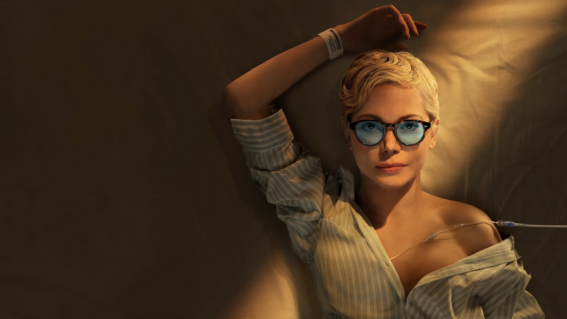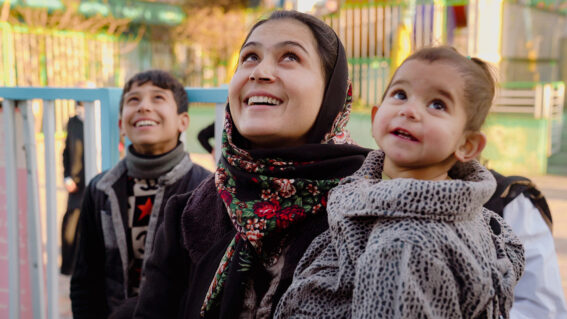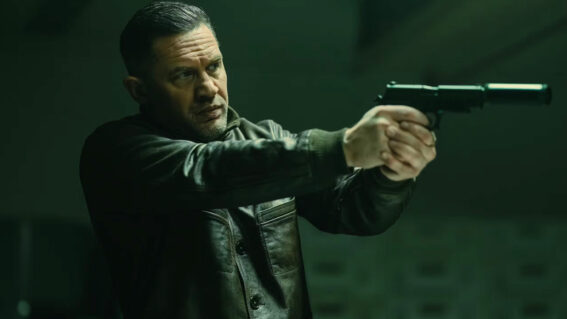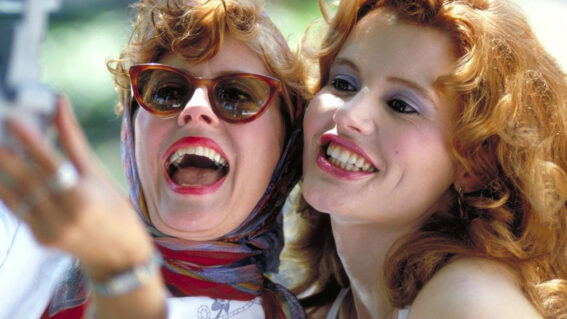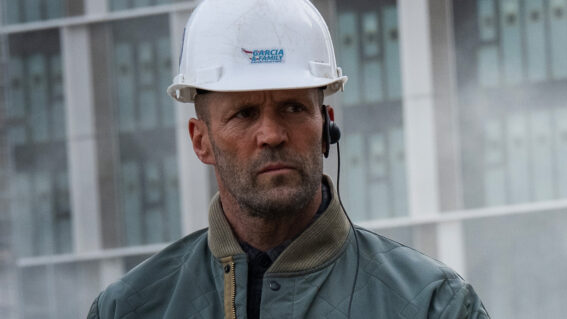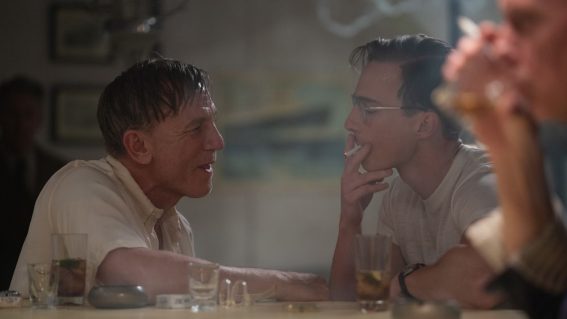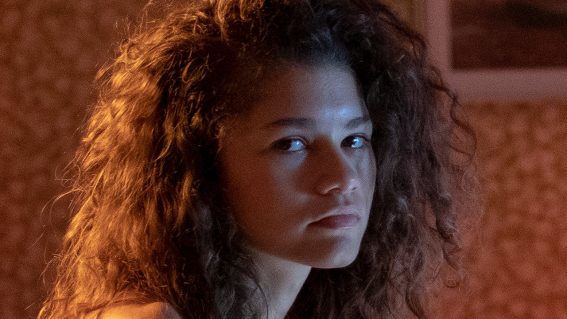The beauty and horror of Sofia Coppola’s The Beguiled
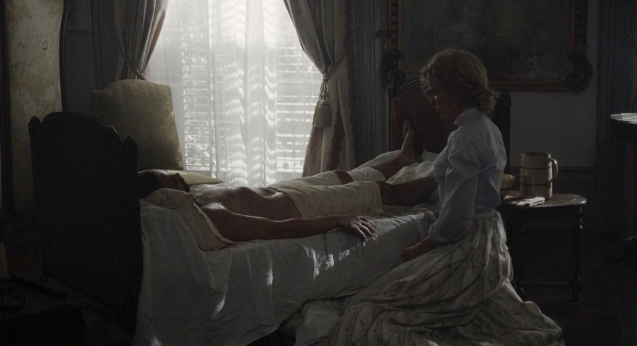
A highlight of last year’s NZ International Film Festival (it was #4 on our best-of list), Sofia Coppola’s Cannes-winning drama is now streaming on NEON.
NEON have sponsored this lovely piece of content, with Amanda Jane Robinson revisiting the film to explore the power dynamics, colonial anxiety, and command of image that stand out in Coppola’s star-studded tale.
Sofia Coppola has always been interested in the beauty and horror fundamental to girlhood, and The Beguiled is perhaps her most literal interpretation of these inherently feminine domains. Three years into the Civil War, The Beguiled observes two teachers and five schoolgirls holed up in a Virginia girls seminary. When a wounded Union soldier unexpectedly arrives, seminary headmistress Martha Farnsworth takes him in as an act of generosity. However, the Corporal’s presence arouses a latent desire in the women, and their efforts to seduce him slowly contort his function into prisoner and plaything. Loving your enemy is, after all, the Christian thing to do.
In a neatly established hierarchy, Nicole Kidman plays headmistress Martha Farnsworth of the Martha Farnsworth Seminary. She embodies the role with a protective restraint and a traditional sensibility, and finds herself overcome by desire for Corporal McBurney, played with roguish masculinity by Colin Farrell. In an early scene, she gives him a sponge bath and is so flustered by his physicality she can barely cope. As water pools in his clavicle, she’s all shallow breaths and sharp exhales.

To Martha’s right, we almost always find head teacher Edwina Morrow, played with a heartbreaking tenderness by frequent Coppola collaborator Kirsten Dunst. Sexually repressed and spiritually lost, Edwina has never been one to know what she wants, until now. It is her jealousy, more than that of the other women, that is most palpable.
Edwina’s immediate rivalry, however, is not with Martha, but with teenage student Alicia, played by Elle Fanning. Alicia’s surliness is conveyed through an eye-roll or a well-timed smirk, an elbow on her desk during a dragging Latin lesson. Though sullen and uninterested in etiquette, she is determined to attract Corporal McBurney’s attention and conspires to use him to satisfy the beginnings of her curiosities.
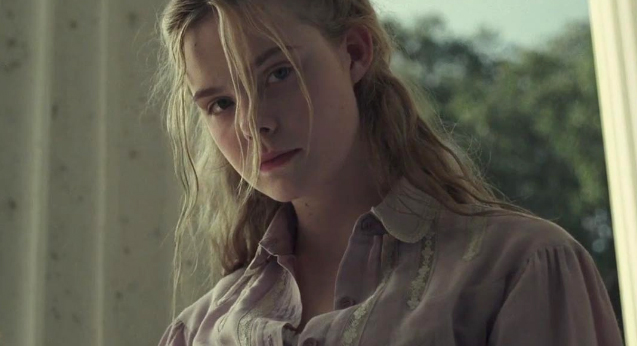
The younger girls; played by Oona Laurence, Angourie Rice, Addison Riecke, and Emma Howard; are too, conspiratorial. Though theirs is not a carnal desire, they’re still desperate for Corporal McBurney to like them, and spend much of the film trying to please and appease him. The cast is at its strongest as an ensemble, whether giggling during prayer, serving supper, or playing a tune.
While the power dynamics in this group of women clearly serves the story, it also adds to the film’s dry humour. In Kidman’s sly, commanding way, Martha’s simple beckoning for Edwina to draw her shawl becomes pure comedy. That competitive chemistry between the women is played out through feminine forms of non-verbal communication; intonation and gesture, costume and glance, etiquette and posture. Every slight turn of the shoulder is an effort towards seduction, which is, of course, an effort towards power.
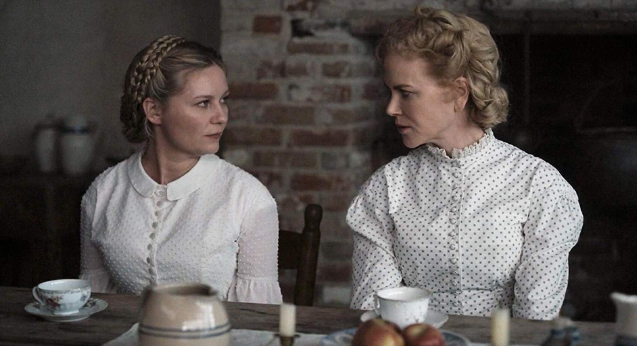
Both Cullinan’s original novel and Don Siegel’s 1971 adaptation also feature the perspective of a black female slave, Hallie (Mae Mercer). Much of the initial discussion around The Beguiled concerned Coppola’s decision to write this character out of her adaptation with nothing more than a line delivered at the beginning of the film to clarify: “The slaves left.” After weeks of condemnation, Coppola issued a statement explaining her decision.
“According to historians and several women’s journals from the time, many slaves had departed, and a great number of white women of the South were left in isolation, holding on to a world whose time had rightly come to an end—a world built on slave labor,” Coppola wrote, calling her resolve “historically accurate.” Plus, she continued: “I felt that to treat slavery as a side-plot would be insulting. Young girls watch my films and this was not the depiction of an African American character I would want to show them.”
In some ways, her stance is understandable. Within the current climate of identity politics, it’s just as likely Coppola would have been criticised for including a token black character, and a slave, at that. And yet, her timid myopia still stings. As Wesley Morris said on New York Times podcast, Still Processing: “I wish she had trusted herself more to handle all of what she was dealing with, otherwise why not just set it somewhere else?” Coppola has often been confined by the tunnel vision of her own experience. It would have been so much more courageous to at least try to grapple, as the Don Siegel adaptation did, with the complexities and horrors of the time.
In the same way that Sam Neill classifies the “cinema of unease” as New Zealand film’s struggle to find, or form, its own identity, The Beguiled recalls a similar uneasiness, an undergrowth of colonial anxiety personified in the southern belle. Coppola has long been interested in this certain kind of white femininity; brooding, insular, concupiscent. It was inevitable, then, that she would find a muse in the women of the southern gothic. That contradiction between the opulent and the derelict seems entirely fitting. And what better setting than a plantation house to embody this duality; somewhere so visually exquisite and yet purpose-built to facilitate one of history’s most grotesque horrors.
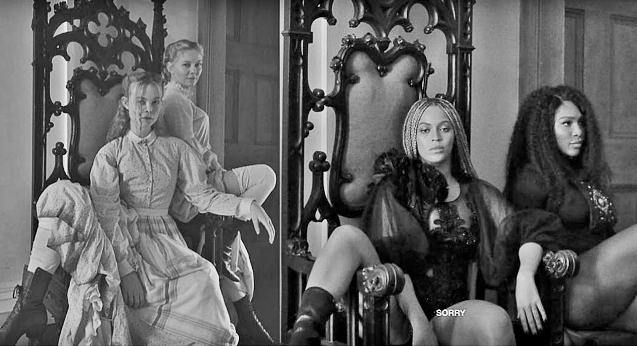
Though the story is set in Virginia, the film’s exteriors, as well as the kitchen and dining room scenes, were filmed at Madewood Plantation House, a former sugarcane mansion in Napoleonville, Louisiana. Madewood is also the location where Beyonce filmed her crucial visual album, Lemonade. In fact, the cast and crew of the film went so far as to impersonate Beyonce and Serena Williams from one of the album’s videos, posing in the same manner and sharing the photographs online. For Coppola to distance herself from culpability for her casting was at least a considered choice. The truly short-sighted decision was to ground her story, which is so specific to the perspective of white women, in one of the most culturally important locations for so many black women.
Upon scouting the location, the film’s crew found that Madewood, which is open to overnight guests and private events, was too meticulously well-kept, too beautiful. Production designer Anne Ross and her team had to supply overgrown vegetation and mock erosion to accurately depict wartime neglect, because it’s not as if Martha and her students were the ones responsible for the garden’s upkeep in the years prior. Angelica Jade Bastien wrote: “When Alicia whines and sloppily tends to the land, I saw the posturing of a young girl only recently aware of the labour black people were forced to do and the privilege she used to enjoy. The untended garden was an unavoidable visual marker for the labour of black people.”
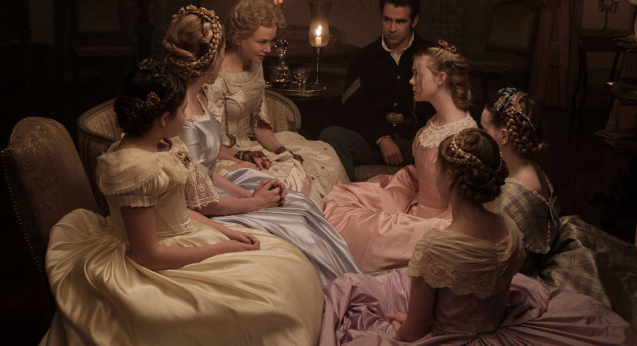
A similar visual marker was present in the costuming; Coppola is no stranger to the sensuality of fabric. Every character wears elaborate gowns, first of thick calico, then silks and gauzy lace. In the previously mentioned episode of Still Processing, Morris’ co-host Jenna Wortham notes that the absence of slaves is keenly felt throughout the film, especially in the realm of costume, asking simply: “Who made those dresses?” Every corner of decay in the film is a result of the deficit of black slave labour; this knife-edge between beauty and horror is tangible.
A consistently visual director, Coppola’s theories on beauty and horror are presented as images rather than arguments; a wounded leg on a velvet pillow, a shattered chandelier, a bloody Victorian nightgown. Naturalistic sounds of crickets at night and larks in the morning morph from comfort to menace, as do the film’s atmospheric visuals. Shifting fog in the evening light has never been so beautiful or so unsettling.
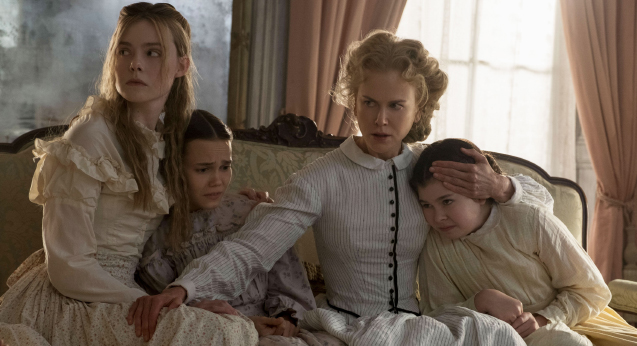
Beauty taken to its most severe end inevitably becomes horror, a thesis perfectly embodied by the women in this film. As the story matures, Coppola’s brilliance becomes evident in the way she turns the women’s beauty into their power. Their feminine domesticity; the way they nurse and heal, the care they put into a meal’s preparation, their dexterity with needle and thread; becomes their weapon. These women finally become mad and monstrous, their beauty turned grotesque by the horrors of dormant desire.
Arabelle Sicardi wrote of beauty: “It’s one of the most obvious evidences we have of femininity and identity creation in history.” These women dress their best, fix their hair and makeup, adjust their posture. They sweep and cook and hang clothes on the line. They perform the small labours of feminine beauty and domesticity in an effort towards seduction, but also to retain a sliver of identity and humanity in the midst of the chaos of war, both in the home and in the fields beyond the plantation. It is this, an attempt at normalcy in the face of such stark violence, that is the most beautiful and most horrific act of all.
This lovely piece of content is brought to you by NEON, where The Beguiled is now available to stream.
If you’re not on NZ’s best streaming service already, click here to sign up to their TV & Movies package now.

